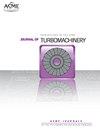不同粗糙度大小和位置对压气机叶栅表面粗糙度影响的实验研究
IF 3.1
3区 工程技术
Q3 ENGINEERING, MECHANICAL
引用次数: 0
摘要
叶片表面粗糙度对压气机气动性能有重要影响。为了探索粗糙度大小和位置对叶片性能的影响,在低速可控扩散型线性压气机叶栅中进行了实验研究。在叶片粗糙度大小和位置变化过程中,采用部分跨度粗糙度法保持轴向速度密度比。基于几何灵敏度分析确定了叶片前缘、吸力面前后和压力面5种局部粗糙度方案,其粗糙度值在Ra = 3.1μm ~ 18.8μm之间变化。测量叶栅进出口流场和叶片表面静压分布,有助于区分叶片性能特性的变化,甚至叶片表面附面层的发展状态。超临界粗糙度状态下存在临界粗糙度效应,叶片损失显著增加,有效入射范围减小。在测量的最大粗糙度条件下,损失增加28.4%,入射范围减小41.2%。本文章由计算机程序翻译,如有差异,请以英文原文为准。
Experimental investigations on the effects of surface roughness for compressor cascades with different roughness magnitude and location
Abstract Blade surface roughness could significantly affect the aerodynamics performance of compressors. To explore the influence of roughness magnitude and location on blade performance, experiments were conducted in a low-speed linear compressor cascade with controlled diffusion airfoils (CDA). A part-span roughness method was employed in the experiment to maintain the axial velocity density ratio (AVDR) during the change of blade roughness magnitudes and locations. Five blade surface local roughness schemes, including the leading-edge, the fore- and aft-part of the suction surface, and the pressure surface, which were determined based on geometry sensitivity analysis, were investigated with the variation of the surface roughness magnitude between Ra = 3.1μm to 18.8μm. Cascade inlet and outlet flowfields and the blade surface static pressure distributions were measured, which could help to distinguish the change of blade performance characteristics and even blade surface boundary layer development state. A critical roughness effect was found and significant blade loss increment and available incidence range reduction appear at super-critical roughness states. At the measured maxi-roughness condition, 28.4% loss increase and 41.2% incidence range reduction were reached.
求助全文
通过发布文献求助,成功后即可免费获取论文全文。
去求助
来源期刊
CiteScore
4.70
自引率
11.80%
发文量
168
审稿时长
9 months
期刊介绍:
The Journal of Turbomachinery publishes archival-quality, peer-reviewed technical papers that advance the state-of-the-art of turbomachinery technology related to gas turbine engines. The broad scope of the subject matter includes the fluid dynamics, heat transfer, and aeromechanics technology associated with the design, analysis, modeling, testing, and performance of turbomachinery. Emphasis is placed on gas-path technologies associated with axial compressors, centrifugal compressors, and turbines.
Topics: Aerodynamic design, analysis, and test of compressor and turbine blading; Compressor stall, surge, and operability issues; Heat transfer phenomena and film cooling design, analysis, and testing in turbines; Aeromechanical instabilities; Computational fluid dynamics (CFD) applied to turbomachinery, boundary layer development, measurement techniques, and cavity and leaking flows.

 求助内容:
求助内容: 应助结果提醒方式:
应助结果提醒方式:


